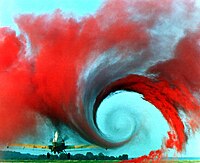
Photo from wikipedia
In this paper, atmospheric optical turbulence strength is estimated for realistic airborne environments using a modified phase-variance approach, as well as a modified slope-discrepancy approach. Realistic airborne environments are generated… Click to show full abstract
In this paper, atmospheric optical turbulence strength is estimated for realistic airborne environments using a modified phase-variance approach, as well as a modified slope-discrepancy approach. Realistic airborne environments are generated using wave-optics simulations of a plane wave propagating through increasing strengths of homogeneous atmospheric optical turbulence, both with and without aero-optical contamination (from in-flight wavefront sensor data) and additive-measurement noise. In comparison to the modified phase-variance approach, the results show that the modified slope-discrepancy approach more accurately estimates atmospheric optical turbulence strength over a wide range of conditions. Such results are encouraging for realistic airborne environments because they can be scaled to different freestream conditions as long as the boundary layer is considered canonical.
Journal Title: Applied optics
Year Published: 2022
Link to full text (if available)
Share on Social Media: Sign Up to like & get
recommendations!